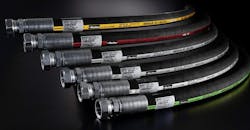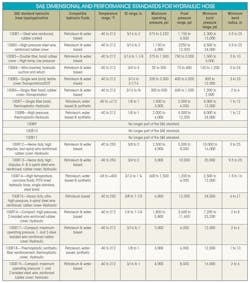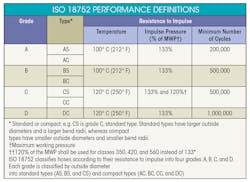Making Sense of Hydraulic Hose Standards
Hydraulic hose construction and performance is covered by various national and international standards including ISO, BSI, SAE, DIN, API, and CETOP. Most proprietary hoses conform to one standard or another, the SAE standards being the most widely followed in the U.S. SAE standards provide general, dimensional, and performance specifications for the most common hoses used in hydraulic systems on mobile and stationary equipment.
For decades, SAE J517 has published guidelines for 100R1 through 100R12 series hydraulic hoses. These manufacturer-driven SAE standards have been based on design, construction, and pressure ratings to ensure that hydraulic hoses meet minimum construction requirements. SAE established minimum pressure ratings for various hoses (inside diameters and were later revised to also include constant-pressure hoses, which are hoses that maintain pressure ratings within a group regardless of size). Some common constant-pressure hoses are R13, R15, R17 and R19.
SAE: The Old Standby
SAE is based on construction technique and material of hydraulic hose. The various application parameters required when selecting hose are size, temperature, fluid type, and pressure, to name a few. Depending on these criteria, the choice of hose construction will change to suit the conditions. The majority of hydraulic machines are not exotic, and typically your standard 100R1 or 100R2 (1-wire and 2-wire, respectively) hoses are appropriate. When extreme pressures or exotic fluids come into play, however, the options for suitable hose are reduced.
Each of the hydraulic hose styles summarized in the table must meet a set of dimensional and performance characteristics as set forth by SAE, and they are designated as 100R1 through 100R19. However, SAE issues no approval source lists, certification, or letters of approval. Adopting these standards by manufacturers is strictly voluntary. Therefore, SAE standards only ensure a similarity of hoses among different manufacturers, and most manufacturers offer hoses that far exceed SAE standards.
Going Beyond Standards
When comparing hose manufacturers, it’s best to consider hoses that exceed the SAE minimum performance and also meet or exceed additional certifications—such as ISO—to achieve the best combination of performance, life, and production costs. For example, Parker Hannifin’s Hose Products Division offers hydraulic hoses with one-half the minimum bend radius outlined in SAE standards at full SAE pressure.
For example, the bend radius of Parker’s 797 hydraulic hose is half of SAE’s 100R1, 100R2, 100R4, 100R12, and 100R13 minimum requirement, which reduces hose length requirements by up to 47%. The tighter bend radius means fewer bent tube fittings and longer life in applications where machinery movement causes hoses to bend sharply. It also means reduced inventory requirements. Another example of exceeding SAE standards is Parker’s 787 hose, which has nearly a 30% smaller outside diameter OD than SAE spiral. The compact design reduces the weight of the hose as well as footprint.
Difference Between SAE and ISO Standards for Hydraulic Hose
More recently, hydraulic system designers began adopting ISO specifications. Many large OEMs switched to ISO standards in their design and manufacturing process to ensure the sale and service of their equipment globally. ISO Standard 18752, released in 2006, takes a different approach centered around the design practices of users who typically design hydraulic systems based on performance and pressure requirements.
ISO 18752 has nine pressure classes for maximum working pressure, ranging from 500 to 8,000 psi. Hydraulic hoses meeting ISO 18752 specifications are classified according to their resistance to impulse pressure in four grades: A, B, C, and D. Each grade requires a specific number of impulse cycles at a certain temperature and impulse pressure in order to meet the standard. In addition, the grade is then classified by the OD of the hose into standard types (AS, BS, CS) or compact types (AC, BC, CC, DC). Compact types have a smaller OD and bend radius than the standard types.
Each grade requires a specific number of impulse cycles the hose must meet at a specified temperature and impulse pressure. The table below explains, in detail, the ISO 18752 performance specifications.
ISO 18752 classifies hoses according to their resistance to impulse into four grades: A, B, C, and D. Each grade is classified by outside diameter into standard types (AS, BS, and CS) and compact types (AC, BC, CC, and DC).
Note that ISO 18752:2014 does not include requirements for end connections. It is limited to the performance of hoses and hose assemblies. The hose assembly maximum working pressure is governed by the lowest maximum working pressure of the components.
Testing for Toughness
The primary concept behind ISO Standard 18752 requires constant-pressure performance ratings in each class for different hose sizes. This specification also requires spiral hose to exceed one million pressure impulse cycles according to ISO 18752 hose grade D, type DC. This requirement is the toughest of all grades and classes to achieve and specifies meeting 248°F temperature and an impulse pressure of 133% of maximum working pressure for at least one million impulse cycles. In this accelerated test, the hose is positioned into a U-shape on a test stand, and the fluid is raised to the specified working pressure. Pressure pulses are also applied at an elevated value to stress the spiral wires and end fittings for a minimum number of required cycles.
The ISO 18752 standard makes it easy to identify what hose should be used on a machine. Strict testing requirements allow users to know exactly what the hose is rated for and how it should perform while on hydraulic equipment. Hoses tested to higher impulse standards are likely to have a longer hose life, which is why many users are switching to ISO standards. For instance, if you need a hydraulic hose for a severe application presenting many repeated pressure cycles in short time and long continuous service, you would select either the grade C or D hose assemblies. However, this selection is based on the hose being correctly installed and protected from harsh environments.
Another important aspect of ISO standards is that they are accepted worldwide, which means wherever your hose is manufactured or purchased, you know it will be tested to the same standards. Global manufacturing standards are essential for many original equipment manufacturers.
A Step Ahead of Standards
In response to market trends for higher-pressure hoses, hose manufacturers have developed families of constant-pressure hoses that meet and exceed ISO 18752 specifications. For example, Parker’s GlobalCore line includes 1,000-, 3,000-, 4,000-, 5,000-, and 6,000-psi hoses. Each constant-working-pressure family has color-coded laylines based on pressure rating and is available with different covers to match application requirements. These hoses meet the minimum 1 million cycles required in ISO 18752 Grade D, Type DC and have been tested up to 2 million impulse cycles and at a tighter bend radius than required by the specification.
Although SAE J517 and ISO 18752 do not require pressure impulse testing while the hose is moving, Parker and other manufacturers do so to further ensure hose longevity. Hoses are flexed while impulse pressure cycles are applied randomly to positively demonstrate hose performance and longevity.
Hydraulic hoses meeting ISO 18752 are specified by the performance definitions below. These ISO definitions identify the grade and type of hose required for different applications based on criteria such as temperature, impulse pressure or cycle ratings.
This material is excepted from material by Kyri McDonough, marketing services manager, and Derek Garceau, engineering manager, both at Parker Hannifin’s Hose Products Div., Wickliffe, Ohio. The original material appears on Parker’s Motion & Technology Blogs. Click here to view the original material.




